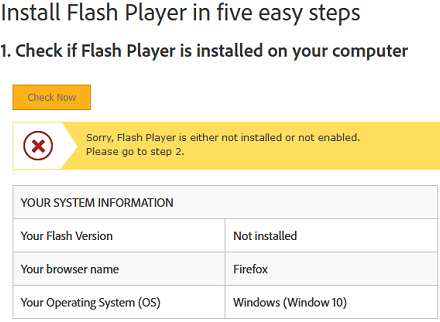The 31st. In December 2020 Adobe will finally end the support of Flash Player. At this point Flash has reached the end of its lifecycle (EOL), no new versions or updates will be released. In this article we explain what a Windows administrator needs to know about the end of Flash Player support.
In 2017 Adobe started advising all developers on the migration of their existing Flash projects to the open formats HTML5, WebGL and WebAssembly. The transition period ends later this year and Adobe will close the Flash Player download site on its website on December 31st.
To check if you have Flash Player installed on your computer/browser, go to the test page at https://helpx.adobe.com/flash-player.html.

By the end of 2020 Microsoft will block Flash in Edge and IE for all versions of Windows. The developers of Firefox and Chrome have also disabled support for Flash Player in the latest versions.
KB4577586: Update Adobe Flash Player to remove Adobe Flash Player on Windows
In October 2020, Microsoft released KB4577586 to remove native Adobe Flash from the supported Windows versions (Windows 8/8.1/10 and Windows Server 2012/2012R2/2016/2019).
- Update KB4577586 only removes the Adobe Flash Player integrated in Windows 10 (and other recent versions of Windows). If you manually download and install Flash Player from the Adobe website or any other source, it will not be uninstalled;
- You cannot uninstall update KB4577586 after its installation. This means that you will no longer be able to install Adobe Flash Player on your Windows device (to use Flash again, you must return to a restore point, reset or reinstall Windows).
The update KB4577586 (Update to remove Adobe Flash Player) is currently only available for manual download from the Microsoft update catalog.

To install the update, simply run the downloaded windows10.0-kb4577586-x64.msu file.


If you try to remove the Adobe Flash Player removal update that disables Flash support in Windows 10, you will get an error:
wusa.exe /uninstall /kb:4577586
Windows Update Standalone Installer
The update for uninstalling Adobe Flash Player is required on your computer and cannot be uninstalled.

Uninstall Adobe Flash Player on an older version of Windows
To uninstall Flash Player in older versions of Windows (Windows 7/XP and Windows Server 2008R2/ 2003) where Flash is not embedded in the image of the operating system, you will need to use a special uninstaller from Adobe. You can download it here https://fpdownload.macromedia.com/get/flashplayer/current/support/uninstall_flash_player.exe.
Close browsers and other applications that can use Flash and run the downloaded uninstall_flash_player.exe file.
You can uninstall Flash using the uninstall_flash_player utility in the background:
delete_flash_player.exe – delete
or to remove a specific Flash extension (ActiveX, NPAPI, PPAPI):
- delete_flash_player.exe – delete activex
- remove_flash_player.exe – remove the plugin
- remove_flash_player.exe – remove pepperpugin
All remaining flash files in the following folders still need to be deleted manually:
C: Windows32MacromedFlash
C: WindowsSysWOW64MacromedFlash
%appdata%AdobeFlash Player
%appdata%MacromediaFlash Player
Disable Flash Player in Windows with WSUS
The update KB4577586 is currently optional in Windows Update and WSUS. Microsoft is likely to recommend it or even make it mandatory in early 2021.
We would like to remind you once again that update KB4577586 cannot be uninstalled after installation.
Update KB4577586 can be imported manually into WSUS
If you receive the error message when importing the update, you must enable support for TLS 1.2 encryption for version 4 of the .Net Framework on the WSUS server. To do this, create a DWORD parameter (32-bit) named SchUseStrongCrypto with a value of 1 under the registration key HKEY_LOCAL_MACHINESOFTWAREMicrosoft.NETFrameworkv4.0.30319. To apply the new settings, you will need to restart your computer.

After importing the update into WSUS, you can share it to install it on a target group of computers/servers (target groups can be created manually in the WSUS console or configured via a GPO).
Related Tags:
update for removal of adobe flash player,adobe flash end of life announcement,why is adobe flash ending,what will replace flash player in 2020,what browsers will support flash after 2020,what happens when flash player is no longer supported,adobe flash player,what will replace adobe flash,what will happen to flash games in 2020,flash player 2020,adobe flash player download,flash player chrome










































































































